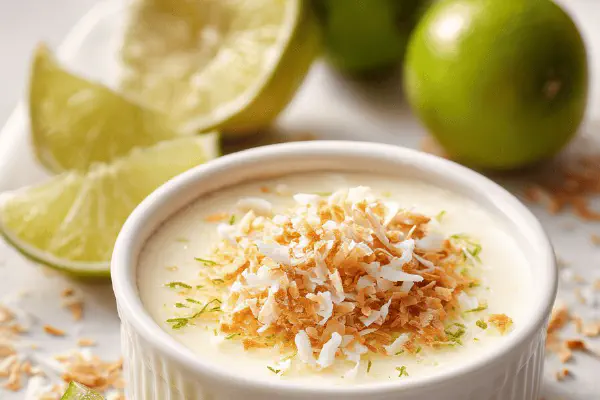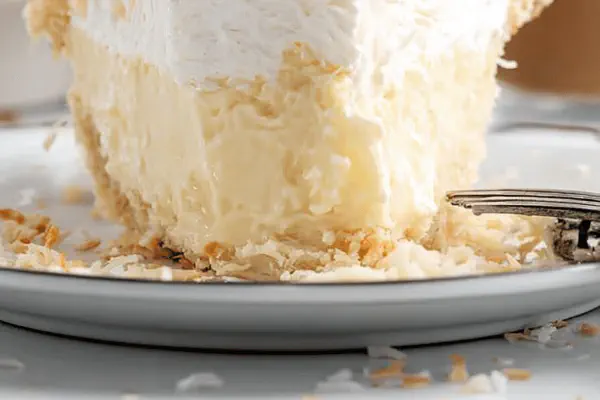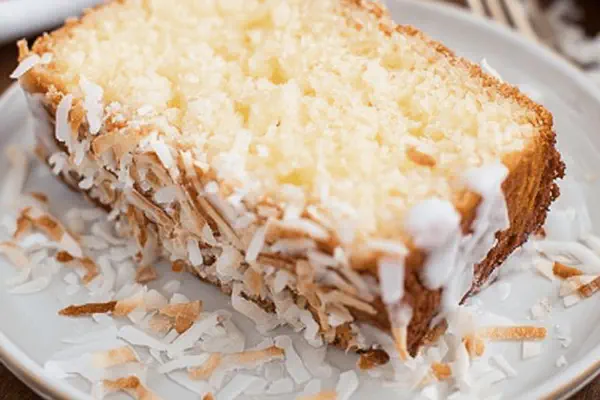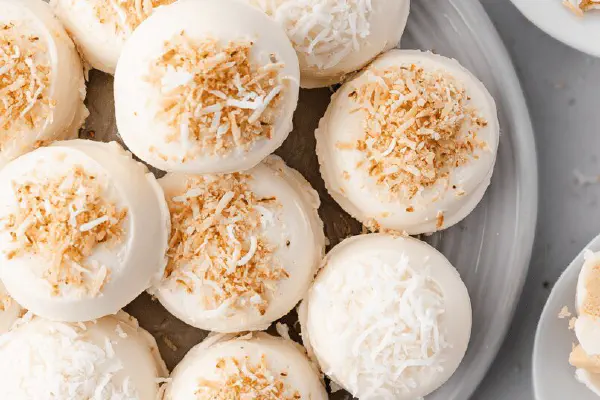Coconut Flan Twist

By Emma
Certified Culinary Professional
Ingredients
- 143 ml sugar (just under 2/3 cup)
- 48 ml arrowroot powder (3 ¼ tbsp)
- 6 egg yolks
- 1/4 vanilla bean, split and scraped
- 1 can 400 ml full-fat coconut milk
- 120 ml whole milk (1/2 cup)
- 120 ml toasted sweetened shredded coconut
- Zest of 1 small lime
About the ingredients
Method
- Off the heat, whisk sugar and arrowroot powder in saucepan; graininess gone. Add yolks in one by one, fold gently avoiding froth. Scrape in vanilla seeds plus pod just for infusion depth. Pour coconut milk plus whole milk, stir until even slurry. The tiny lime zest shreds go in last here—brightens before heat hits.
- Medium heat next. Stirring constantly with balloon whisk—don’t glance away—just as steam rises, bubbles gather, mixture thickens. Almost pudding state. Look for that slow rise and sheen as the edges start to grab hold and you feel resistance on whisk. Remove immediately. Too long? Gritty, split custard.
- Strain through fine sieve into measuring jug; discards vanilla pod and any lumps. Pour quickly into six 125 ml ramekins. Cover directly with cling film pressed to surface—no skin. Chill minimum 3 hours, ideally overnight.
- Final touch, scatter toasted shredded coconut just before serving. Adds crunch and fresh nuttiness to creamy base. Lemon zest can be swapped for fresh orange for different brightness. Arrowroot keeps texture clean without cloudiness cornstarch can bring.
- Common fail: overheat custard thickens unevenly or curdles under reckless stirring. Constant movement, moderate heat. Use balloon whisk for aeration and even cooking. Ramekins size important, smaller = faster cooling and better set. No ramekin? Glass or small bowls work but adjust fill level.
Cooking tips
Chef's notes
- 💡 Off heat mixing crucial. Sugar plus arrowroot in cool saucepan, stir until no graininess. Egg yolks add slow; fold gently no froth. Vanilla seeds and pod stay till after cook for depth then discard. Pour in coconut and whole milk slow, mix slurry even. Lime zest last, fragile, wakes bright aroma before heat.
- 💡 Mid-cook heat control critical. Medium heat only. Whisk nonstop balloon style, watch bubbles peaceful then thickening sets in. Custard changes slow, edges grab whisk. Remove way before solid set or gritty breaks happen. Patience here pays, hurry and suffer split or stringy texture. Listen to bubbling, watch sheen, no glance away.
- 💡 Strain custard through fine sieve or risk clumps, pod bits. Measure quickly into six 125 ml ramekins. Cover surface tight with cling film pressed down, skin forms if loose and ruins texture. Chill 3+ hours. Overnight better. Move ramekins carefully, no shaking custard jostles and can cause uneven set.
- 💡 Final crunch from toasted shredded coconut key. Dry fry till golden, no burn, aroma pops. Sprinkle just before serving keeps texture bright against creamy base. Lime zest swaps: fresh orange zest or kaffir lime leaves add variation but keep citrus snap. Arrowroot good for clean clear flan, cornstarch clouds or thickens dull.
- 💡 Watch overheating common fail. Custard curdles or breaks with reckless stirring or too quick heat. Constant movement, moderate heat. Use balloon whisk, keeps air in, evens cook. Ramekin size affects cool down and set time. Smaller fills speed chill, faster set. No ramekin? Use glass or bowls, fill less to mimic result.
Common questions
Why no skin on flan?
Press cling film tight to avoid skin. Skin forms if air hits surface. Wrinkles or grainy feel. Chill with film. Skipping means dry patches. Skin blocks smooth texture, loses that custard cream feel.
Can I swap arrowroot?
Cornstarch works but flan turns cloudy, texture heavy. Agar agar vegan option, different setting method, more jelly than pudding. Tapioca less predictable. Arrowroot best for clear, soft set but watch heat carefully, overheated turns stringy.
What causes gritty custard?
Overcooking main cause. Heat too high or whisk pause equals split eggs, grit. Rushing thickening wrecks texture. Constant stir key. Also old starch lumps create grainy bits. Strain before ramekins crucial, catches cooked bits, pod.
How to store leftovers?
Cover ramekins tight with plastic film or airtight container. Refrigerate. Custard keeps few days safe. Freeze no, texture breaks freeze-thaw. Label date. Room temp no, risk spoil. Easy to re-whisk custard prior to pouring if reheated but set changes.



